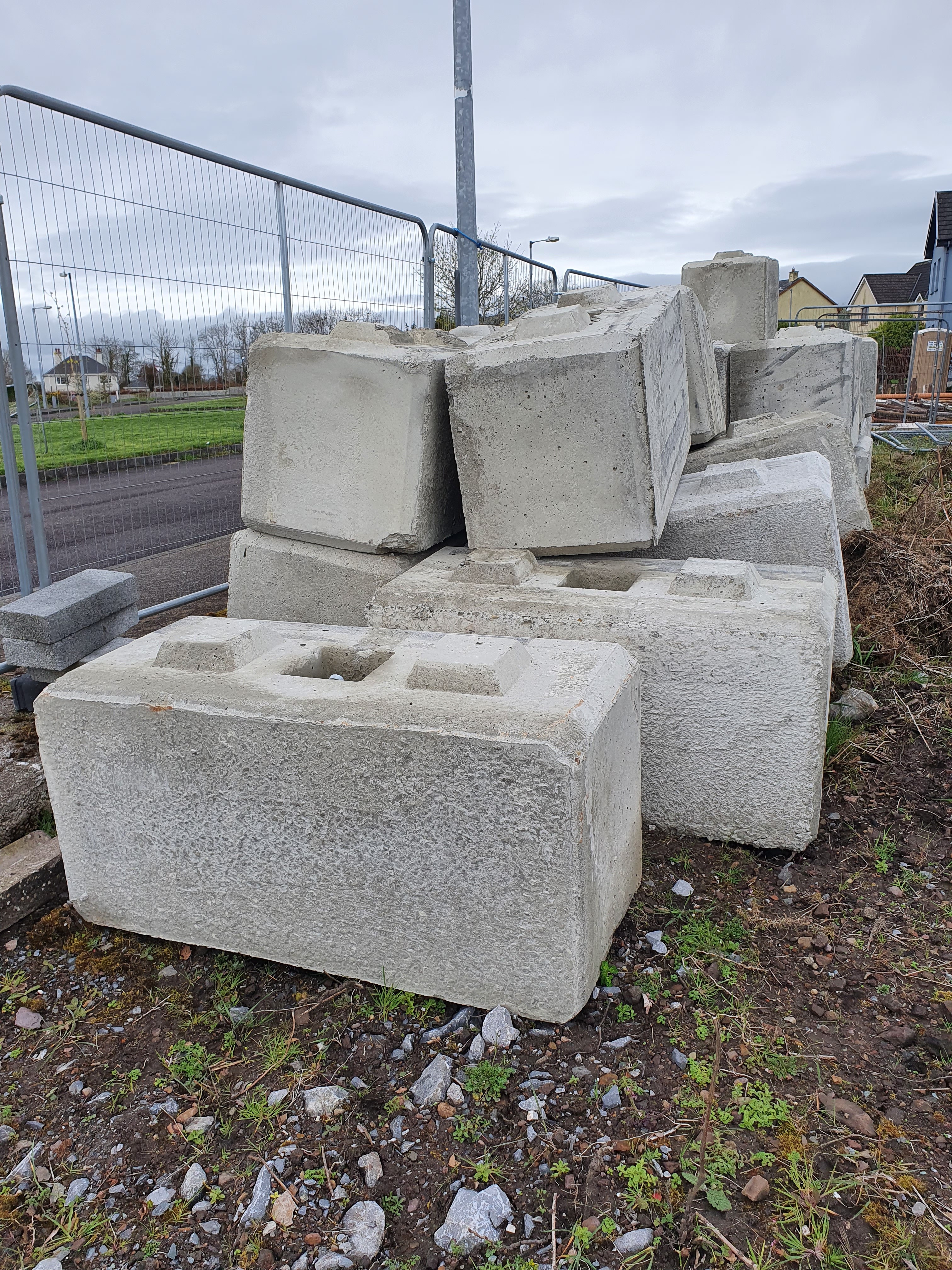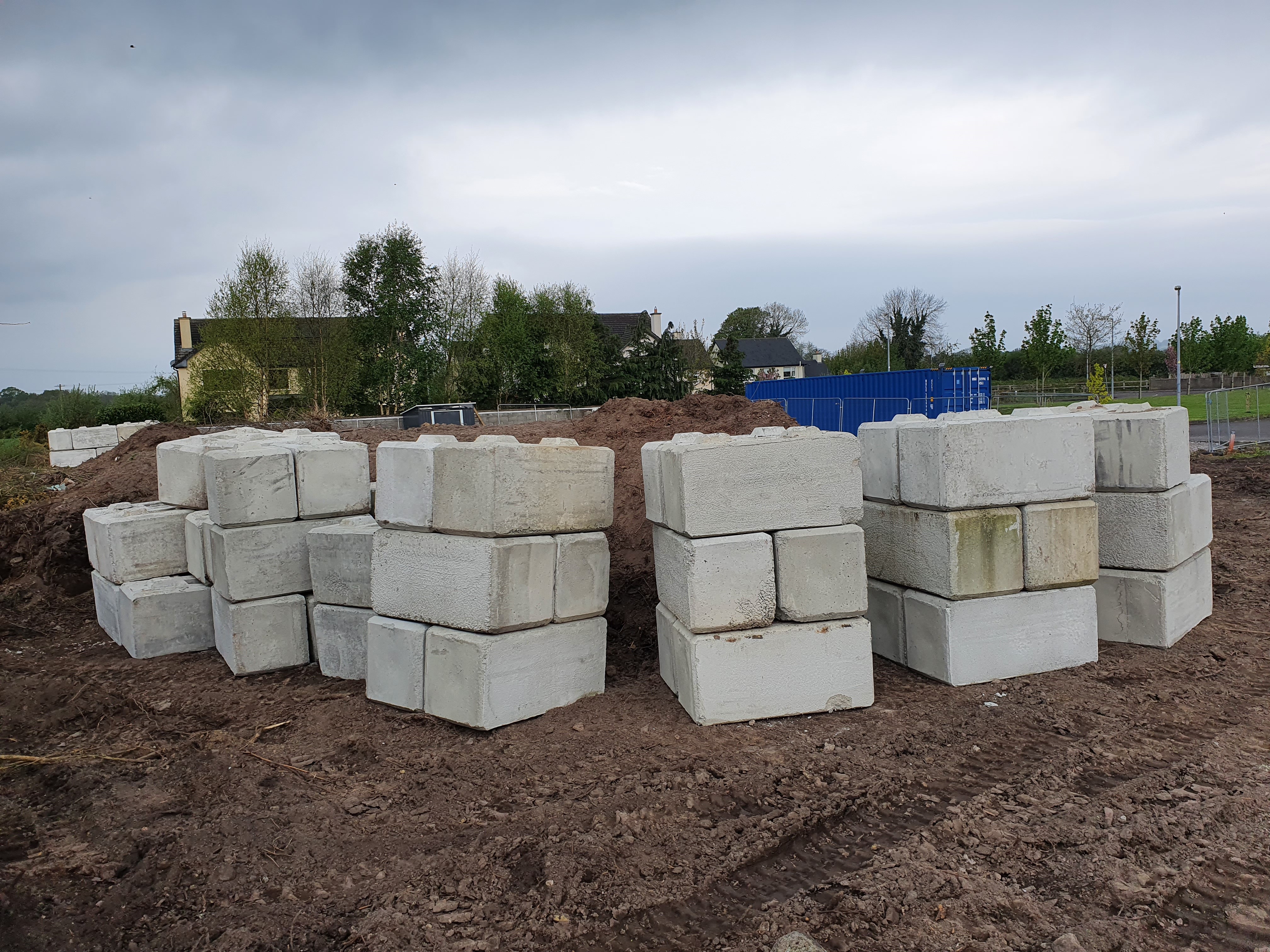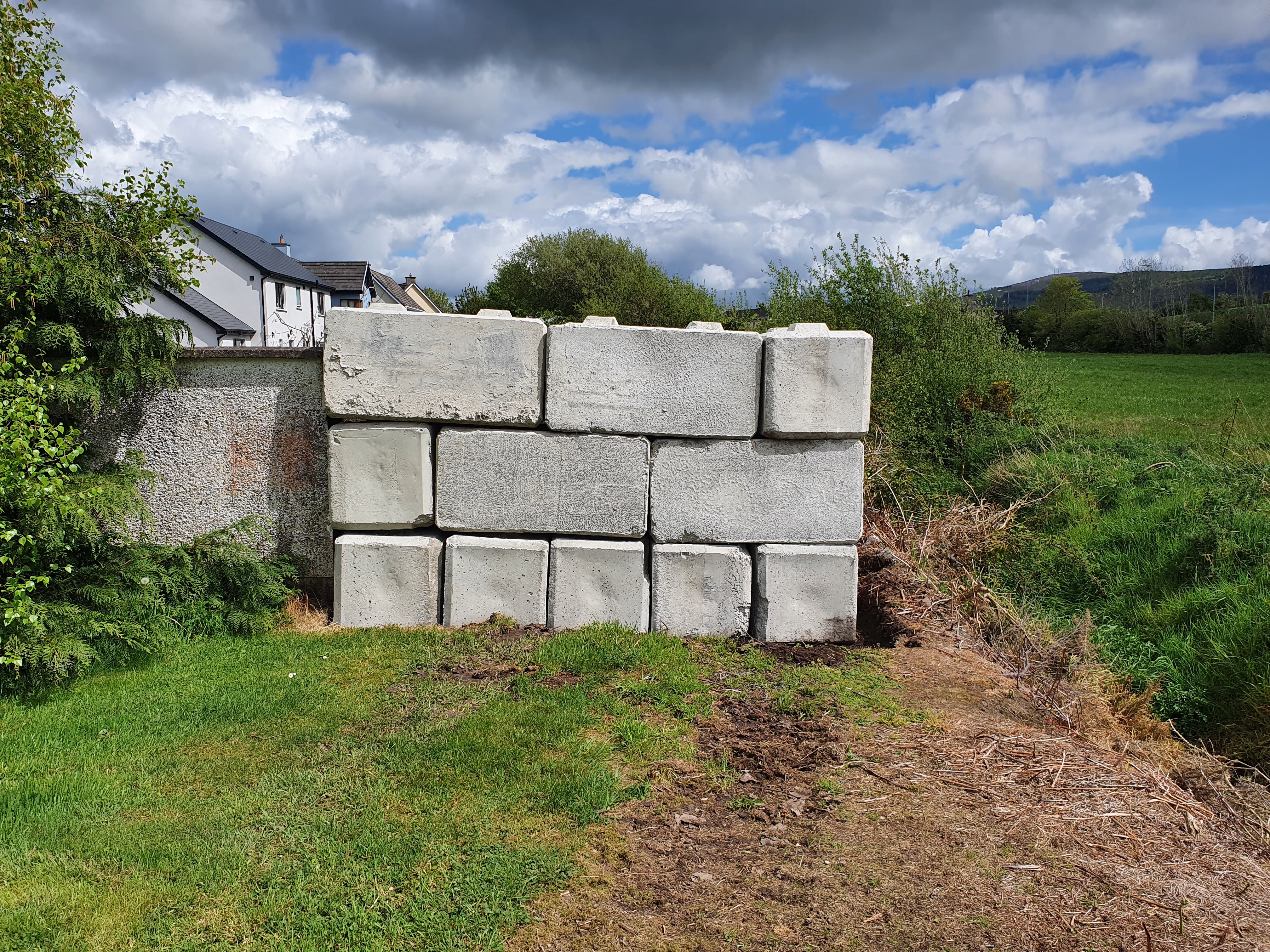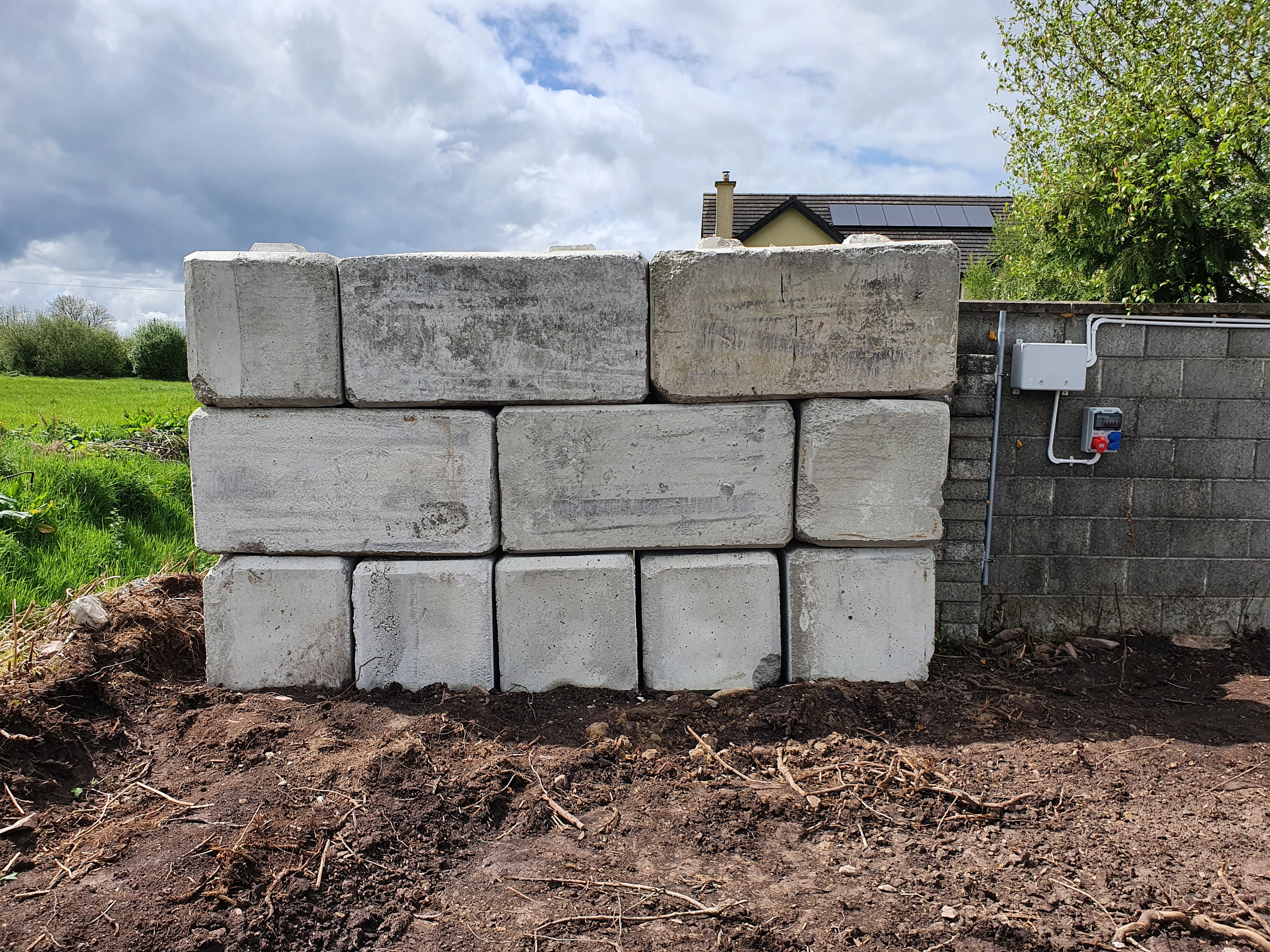Word count: 1201. Estimated reading time: 6 minutes.
- Summary:
- The “lego” concrete blocks, weighing 1.4 tonnes each, were purchased for €68.10 inc VAT and delivery per block. They have a volume of exactly two thirds of a m³, making them good value compared to ready mixed concrete. The supplier’s pricing was likely influenced by the blocks being made from leftover concrete in their trucks.
Saturday 6 May 2023: 22:44.
- Summary:
- The “lego” concrete blocks, weighing 1.4 tonnes each, were purchased for €68.10 inc VAT and delivery per block. They have a volume of exactly two thirds of a m³, making them good value compared to ready mixed concrete. The supplier’s pricing was likely influenced by the blocks being made from leftover concrete in their trucks.
Firstly, this is what they look like, this is the pile dropped at the front of the site:

They may look uninteresting at first glance, but they have some interesting characteristics. They are 1.4 tonnes in weight each, 1.4m long, 0.7m high and 0.68m wide. ‘That’s a weird width?’ I hear you ask? It’s explained by the volume: 1.4 x 0.7 x 0.68 = 0.666, or exactly two thirds of a m3. I paid €68.10 inc VAT and delivery for each of them. That makes them €102 inc VAT per m3, when ready mixed concrete is currently costing north of €140 inc VAT per m3 depending on delivery quantity. This makes them rather good value!
Most other suppliers were looking for €100-140 per block delivered, only one was looking for around €90. So I lucked out in finding a supplier keen to turn inventory into cash before the surely soon building downturn.
Pricing them higher than ready mix is somewhat disingenous of the sellers of these blocks however. They’re actually made from the leftovers in the ready mix trucks when they return to base due to a customer ordering more than they needed, so the concrete was already paid for once. Sure, the galvanised steel reinforcement frame which also provides a lifting loop might cost maybe €30, and the casts will cost a few bob, however I think these are likely quite profitable at over a hundred euro per block. At €68, well, I suspect he wasn’t making much profit if his input costs are what they are now – however chances are he was churning out those blocks over the past few years, and most of them were made back when concrete was a lot cheaper. In any case, they are vastly cheaper than a concrete block wall, never mind an earth retaining wall. They are bulky however, so you swap space consumed for reduced price.
Luckily due to having two merged sites I have the space to swap for reduced costs, so that works for me. Using the digger, I firstly sorted the blocks into ‘ugly’ and ‘pretty’, where ‘ugly’ is defined as blocks with chips in their sides and ‘pretty’ are blocks without chips in their sides (though they can have them at their ends). The ‘pretty’ blocks will be exposed to view permanently, so I want to be looking at a smooth-ish surface. The ‘ugly’ ones will be behind retained earth, so I’ll never see them.
I stacked the ‘pretty’ blocks in a newly cleared rear space I created with the digger, which puts them next to where they’ll be used after my neighbour finishes his part of the boundary fence.

You may be able to notice that the blocks at the back left the third row is sloppy. Those were my first ever attempts to get the digger to raise the blocks that high, and there is a skill to it because the digger really doesn’t like lifting 1.4 tonnes that high. By the time I got to doing the columns on the right however I had it down to a fine art, if I do say so myself. Each of those columns in 2.1m high, and I made sure when climbing over them that I could not cause anything to move nor relocate with all my adult strength. I can’t stop the local children climbing on them, but they definitely will never be crushed by a falling block, those blocks are extremely secure.
To lift the blocks one needs a 16 mm diameter shackle rated for two tonnes to fit the lifting loop in each block. I bought these from Amazon for an absurdly low price:

About £50 for all those shackles. Madness. Are they any good however? Well I did do my research, those are Titan Marine shackles, the low end (yellow) not high end (black) ones. They are made in China with the original Canadian manufacturer having been bought out by a Chinese company, and Practical Sailor’s 2015 review of anchor shackles found them absurdly better than rated specification in their empirical testing, they broke at 43% more load than their rating. Interestingly, the yellow ones performed identically to their black ones, yet cost a fraction of the price. One suspects that they are actually the exact same shackle, just with two pricing strata (alas, the black ones claim to be 67% stronger than the yellow, so snapping at 43% more means they fail their claimed specification).
Having been very mean to those shackles over three days, I can confirm that they did not even remotely deform nor bend nor even jam their pins. They absolutely breezed through what I put them through. This suggests that they are indeed very very strong. They did, annoyingly, produce a lot of metal slivers from grinding which become splinters in your hands. Most painful, and much tweezering was needed each night (I couldn’t use gloves, as I couldn’t screw or unscrew the shackle in the limited space with gloves on).
Whilst the ‘pretty’ blocks went into those columns, the ‘ugly’ blocks went to seal the back corner of my site where the western wall stops early – there is about a 3.5 metre gap there through which anybody could drive anything. I had been concerned for some time that that was the obvious place to steal building materials, so blocking it off securely was desirable. Let’s see anybody get through this in a hurry:


This is actually temporary, I didn’t have the time to do better last weekend. Some other weekend I’ll rent that digger again and redo that bit properly – I need to lay crushed rock foundations, compact that down to a firm flat layer, then lay the blocks straight with a connected L-shaped earth retaining wall. There will be a 1.4m wide space between that outer wall and the earth retaining wall, that is for plant and pumps and it’ll be mostly covered from the elements to keep the rain off it. This will make use of a spare roofing metal sheet which Irish rollforming threw into my order unexpectedly for free.
Getting that done will be a while away. Completing the neighbour’s boundary wall will be higher priority, but I’m blocked on his contractors for that.
Anyway, I have to admit these ‘lego’ concrete blocks have been a real joy to use. They’re easy to move around and lay with just me alone, unlike a lot of other building techniques. They’re a touch ugly true, but they’re vastly cheaper than labour doing a concrete block wall or especially retaining wall. They also make a most satisfying ‘clunk’ noise when you drop them in. And what adult doesn’t want to build stuff from grown up Lego blocks?
| Go to previous entry | Go to next entry | Go back to the archive index | Go back to the latest entries |